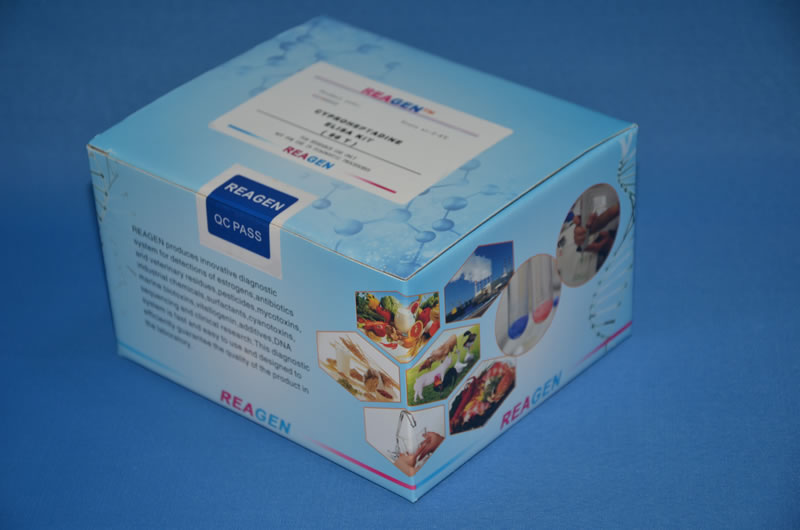REAGEN™ Acrylamide-ES elisa kit is an immunoassay for the detection of Acrylamide.
This test is suitable for the quantitative and/or qualitative detection of Acrylamide in food samples. Samples requiring action should be confirmed by HPLC, GC/MS, or other conventional methods.
Test sensitivity:Aqueous solutions 2.5 ppb (lower LOD can be obtained with SPE); Food samples 25 ppb (contact Abraxis for alternative procedures to obtain LOD 25 ppb in food samples).
Test reproducibility: Coefficients of variation (CVs) for standards: 10%; CVs for samples: 20%.
Selectivity: This ELISA recognizes Acrylamide and not related compounds
Cross-reactivities: Acrylamide 100%
Acrylonitrile 2.1%
Std 0-Std 6: Standards
0; 2.5; 5; 10; 25; 50, 200 ppb
Control: 20 +/- 5 ppb
shelf life:12 month
spec:96T
The Acrylamide ELISA is an immunoassay for the detection of Acrylamide. This test is suitable for the quantitative and/or qualitative detection of Acrylamide in food samples. Samples requiring action should be confirmed by HPLC, GC/MS, or other conventional methods.
 The standard solutions in this test kit contain small amounts of Acrylamide. In addition, the substrate solution contains tetramethylbenzidine and the stop solution contains diluted sulfuric acid. Avoid contact of stopping solution with skin and mucous membranes. If these reagents come in contact with the skin, wash with water.
The standard solutions in this test kit contain small amounts of Acrylamide. In addition, the substrate solution contains tetramethylbenzidine and the stop solution contains diluted sulfuric acid. Avoid contact of stopping solution with skin and mucous membranes. If these reagents come in contact with the skin, wash with water.
The Acrylamide ELISA Kit should be stored in the refrigerator (4–8°C). The plate, standard/control, color and stop solutions must be allowed to reach room temperature (20-25°C) before use. Reagents may be used until the expiration date on the box. The Enzyme Conjugate is supplied in a lyophilized form (3 vials). Before each assay, the required volume of lyophilized conjugate must be reconstituted with the appropriate diluent (see Test Preparation section). Reconstitute only the amount needed for the samples to be run, as the reconstituted solution will only remain viable for one day. Standards, controls and samples need to be derivatized before assaying and must be derivatized and run the same day.
The test is a direct competitive ELISA based on the recognition of Acrylamide by specific antibodies. Acrylamide, when present in a sample, and an Acrylamide-enzyme conjugate compete for the binding sites of rabbit anti-Acrylamide antibodies in solution. The Acrylamide antibodies are then bound by a second antibody (goat anti-rabbit) immobilized on the microtiter plate. After a washing step and addition of the substrate solution, a color signal is produced. The intensity of the blue color is inversely proportional to the concentration of Acrylamide present in the sample. The color reaction is stopped after a specified time and the color is evaluated using an ELISA reader. The concentrations of the samples are determined by interpolation using the standard curve constructed with each run.
- Limitations of the Acrylamide ELISA, Possible Test Interference
Numerous organic and inorganic compounds commonly found in samples have been tested and found not to interfere with this test. However, due to the high variability of compounds that might be found in samples, test interferences caused by matrix effects can not be completely excluded. Mistakes in handling the test can also cause errors. Possible sources for such errors can be:
Inadequate storage conditions of the test kit, incorrect pipetting sequence or inaccurate volumes of the reagents, too long or too short incubation times during the immune and/or substrate reaction, extreme temperatures during the test performance (lower than 2°C or higher than 8°C during the first incubation or lower than 10 °C or higher than 30°C during the color incubation step), inappropriate sample clean up or derivatization.
The Acrylamide ELISA kit provides screening results. As with any analytical technique (GC, HPLC, etc.), samples requiring some action should be confirmed by an alternative method
bio-equip.cn





 The standard solutions in this test kit contain small amounts of Acrylamide. In addition, the substrate solution contains tetramethylbenzidine and the stop solution contains diluted sulfuric acid. Avoid contact of stopping solution with skin and mucous membranes. If these reagents come in contact with the skin, wash with water.
The standard solutions in this test kit contain small amounts of Acrylamide. In addition, the substrate solution contains tetramethylbenzidine and the stop solution contains diluted sulfuric acid. Avoid contact of stopping solution with skin and mucous membranes. If these reagents come in contact with the skin, wash with water.